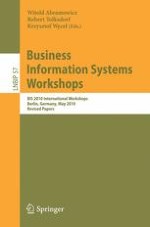Business information systems is a rapidly developing domain. There are many topicsthatdeserveattentionbuthavenotyetfoundaplaceincanonicalresearch. Workshops give researchers the possibility to share preliminary ideas, ?rst - perimental results, or to discuss research hypotheses. Discussions held during presentations strengthen the paper and prepare it for publication. From our - perience, workshops are a perfect instrument with which to create a community aroundvery speci?c researchtopics, thus o?ering the opportunity to promote it. Topics that do not ?nd critical feedback at the main International Conference on Business Information Systems (BIS) may experience fruitful discussion when confronted with a well-focused audience. Over the last few decades, business informationsystems have been one of the most important factors of the transition toward a knowledge-based economy. At the same time they have been subject to continuous rapid development and innovation driven both by industry and by academia. For the last 12 years these innovations were carefully observed but also shaped by researchers attending BIS yearly.
